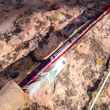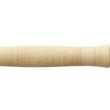The act of catching a memorable fish is the product of a series of small miracles. First, the right fly pattern needs to be chosen, followed by an effective presentation. Then, a willing fish needs to take the pattern. Finally, the angler must properly set the hook and play the fish. These events are interrelated, and success is difficult to come by if all four are not done correctly. The focus of this piece is on setting the hook—one of the most overlooked aspects of successfully landing a fish.
I’m not too concerned with landing most fish at this state in my angling life, but occasionally one hooks into a rare or large fish you really want to bring to the net. Nothing is more frustrating than wanting to bring a fish to hand only to have it come unbuttoned due to a poor hookset. While there’s not always a right or wrong way to set the hook, there are several things that are important to consider when trying to secure a good connection between hook and fish.
Checking Hook Shape and Form
By checking hook shape and form, I’m referring to inspecting your hook to see if it has become malformed after a snag or playing a large fish. Many dry fly hooks are thin-gauged wire and will easily bend when playing a heavy fish, pulling your fly from a snag or a fish’s mouth, or when using pliers to bend down the barb. It doesn’t take much force to bend even the best quality dry fly hooks, so make sure to frequently check your hook before making a cast. For example, I’ve noticed that many of my Penn State fly fishing students accidently bend their hook points when pinching down the barb before starting to tie a fly onto the tippet.
If you’re unsure whether your hook is bent, use the hook of a new fly as a reference.
Checking Hook Sharpness
Checking the hook’s sharpness is easy. Try scratching the hook point on the top of a fingernail. A scratch indicates a sharp hook point. If the point fails to leave a scratch mark, then you’ll need to use a hook file to sharpen the hook or you may need to change flies. Hook sharpness is essential when fishing with thicker point streamer hooks. The thicker the hook point, the sharper the point needs to be when attempting to penetrate, which leads me to the next point.
Hook Wire Thickness Determines Amount of Force Needed
The amount of pressure needed during the hook set is dependent on the hook's wire thickness. Most modern barbless dry fly and nymph hooks possess a hypodermic needle-like thickness and require very little force to penetrate a fish’s mouth. This is why a trout set (i.e. using the soft rod tip to set the hook) is all that is needed when fishing most dry fly and nymph hooks. On the other hand, streamer hooks are thicker and will require more hook set force, which is the reason using a strip set (i.e. pulling straight on the line with the line hand) is usually a better tactic for burying a hook into a fish’s mouth.
Using Correct Language for Strip Setting and Trout Setting
One of the best tips for training your mind when to use the strip set versus a trout set came from a former client of mine while guiding a streamer fishing outing years ago. As a young and excitable guide at the time, I would get caught in the moment when seeing a large trout attack a streamer and would yell, “set the hook.” And guess what? The client used a trout set instead of a strip set because I frantically told him to “set the hook.” After the third missed streamer eat, my client calmly said to me, “George, you are telling me to set the hook so I instinctually lift my rod to set the hook. Instead, tell me to keep stripping the line.”
This kind gentleman was a great client but also a psychologist and understood how my choice of language influenced his hook set. So, now I tell myself and clients to “keep stripping” if I want to use a strip set (i.e. rod tip pointed straight at the fish and pulling hard with the line hand) and use the word “set” when I want to set the hook while lifting vertically with the rod tip. This is the language that works best for me, but you should think about and use the words/terms that make it work for you.

Using Brighter Lines for Beginner and Intermediate Anglers
Slack is a killer for any good hook set. If there’s excessive slack in your line, when you attempt to set the hook, your rod tip must move several feet to pick the equivalent length of slack line/leader before you can create enough force to set the hook into a fish’s mouth. A common mistake beginning anglers make is using a dull (aka camo) line they cannot see well when it is laying on the water. While these lines are very popular these days and while I use them myself, they are often not well suited to beginner and intermediate anglers.
Instead, I recommend using a brighter line as this allows the angler to focus on the fly/indicator and use their peripheral vision to detect whether slack is accumulating on the water. If too much slack occurs, a few longer and quicker strips of the line hand clean up the slack, allowing for immediate tension when lifting the rod tip to set the hook—or to pick up line to make a backcast.
In time you’ll get a feel for slack on the water without having to see the line. Then, and only then, would I suggest switching over to a stealthily colored fly line—and only if your fishery demands it. Truthfully, I think that line mass (i.e. line weight) and the force of the line hitting the water is more important than line color. However, there are freshwater and saltwater environments where a dull-colored line could put the odds in your favor.
Wrapping Up
An entire book could be written about setting the hook, but these concepts are some of the most important. Just remember: even the best closing pitchers don’t always seal the deal, just as the best fly fishers don’t always land the fish of the day. Understanding these five concepts won’t solve all your fish hooking woes, but they should stack the odds in your favor during your next outing.
































Comments
Richard replied on Permalink
Guides in the Bahamas tell clients "long strip" when they want the hook set. That usually follows some sequence of "strip, short strip, stop, strip....." The "long strip" is the hook set. They know to avoid the word "set". They may even tell clients "no trout sets".
Pages